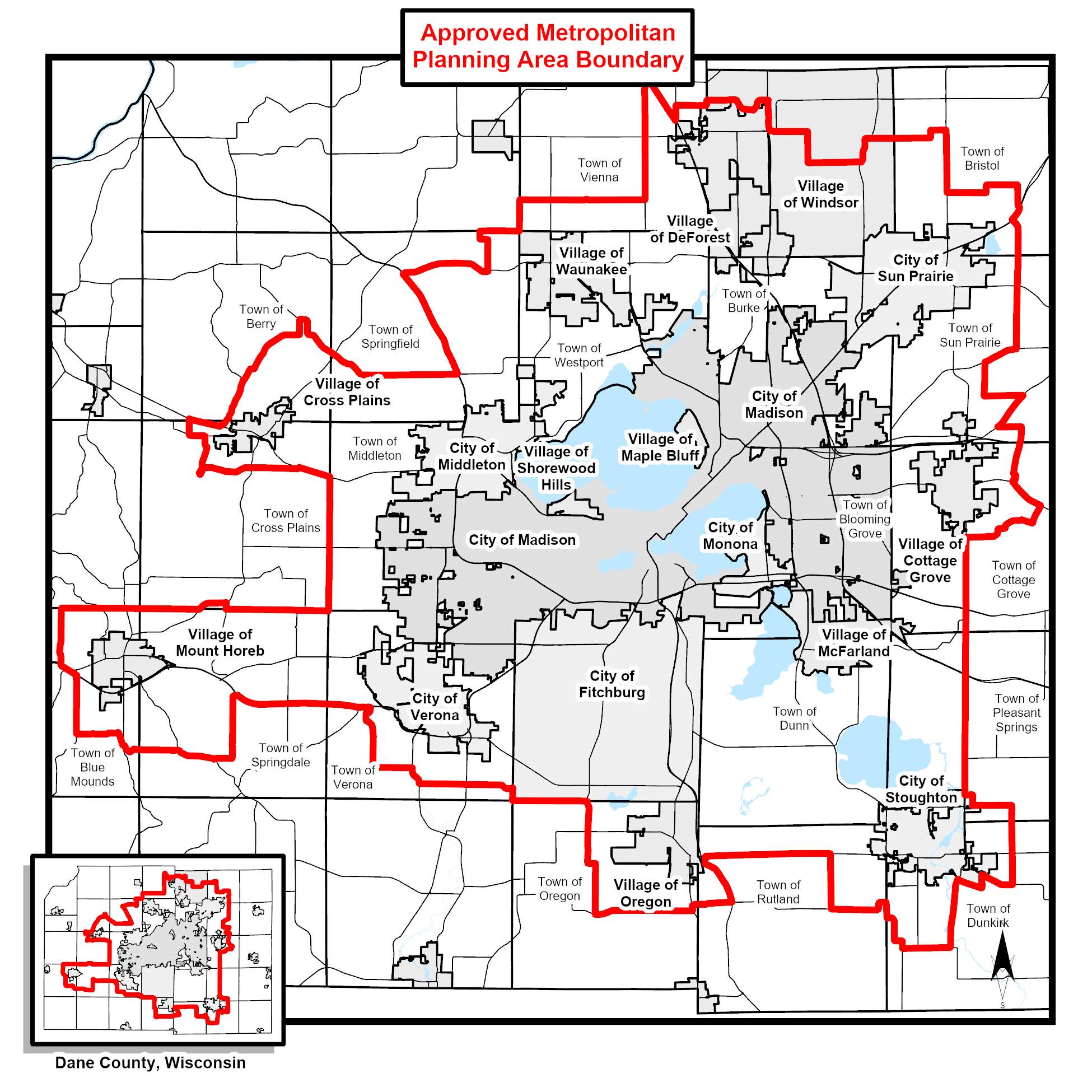- Search
- Outside Resources
- Commute Options Information
- Contact Us / Get Involved
- Español
- Civil Rights / Title VI
- Newsletter
- Webinars
100 State St.,
Suite 400
Madison, WI 53703
Contact:
Tel: (608) 266-4336
Email: MPO
Hours:
Monday - Friday
8:00am to 4:30pm
MPO employees are working remotely part-time. For this reason, please contact staff before visiting the office in person.
MPO PROFILE
What is the Greater Madison MPO?
The Greater Madison MPO is the federally designated Metropolitan Planning Organization (MPO) for the Madison Urban Area. As the MPO, it is the policy body responsible for cooperative, comprehensive regional transportation planning and decision making for the Madison Metropolitan Planning Area. The goal of the MPO planning process is to build regional agreement on transportation investments that balance roadway, public transit, bicycle, pedestrian, and other transportation needs and support regional land use, economic, and environmental goals. The Madison Metropolitan Planning Area includes the Madison Urban Area and all or portions of the 34 contiguous villages, cities, and towns that are or are likely to become urbanized within the 20+ year planning period as well as other areas containing important regional transportation corridors. Federal rules require the designation of MPOs in urbanized areas of 50,000 or more in population as a condition for spending Federal highway and transit funds.
Madison Metropolitan Planning Area |
Currently consists of:
|
Responsibilities
The primary responsibilities of the Greater Madison MPO include:
- Carrying out a cooperative, continuous, and comprehensive planning process for making transportation investment decisions in the metropolitan area with program oversight from the Federal Highway Administration, Federal Transit Administration, and Wisconsin Department of Transportation (WisDOT).
- Preparing and maintaining a long-range multi-modal regional transportation plan.
- Preparing a transportation improvement program to provide for transportation investments to meet metropolitan transportation needs.
- Other duties as required to comply with state and federal regulations, including ensuring that no person be excluded from participation in, be denied the benefits of, or be otherwise subjected to discrimination under any program or activity. See the USDOT Transportation Planning Capacity Building (TPCB) program Case Study: Greater Madison Metropolitan Planning Organization's Approach to Transportation Equity for more information about how the MPO works to ensure equity in its planning and decision-making processes.
While the Greater Madison MPO provides regional coordination and approves use of Federal transportation funds within the metropolitan planning area, responsibility for the implementation of specific transportation projects lies with WisDOT, Dane County, City of Madison, and other local units of government as transportation providers.
History
The Greater Madison MPO was created through an agreement between the Governor, the City of Madison, and other municipalities in the Madison Urban Area making up over 80% of the population. The agreement, which became effective May 2, 2007, redesignated the MPO for the Madison Urban Area in accordance with Federal law. The Transportation Planning Board assumed the responsibility to conduct transportation planning and programming for the metropolitan area from the previous MPO, the Madison Area MPO, following the MPO’s reorganization. MPOs have served the Madison Urban Area since 1973. Areawide transportation planning in the Madison area dates back to 1961, just prior to the time Federal statutes began to require a “3C” (continuing, comprehensive, and cooperative) planning process as a condition of Federal transportation financial assistance.
Guiding Legislation
MPOs currently operate under the Fixing America’s Surface Transportation (FAST) Act, signed into law in December 2015. The FAST Act continues and builds upon the transportation policies and planning, programming, and funding framework established by the previous Federal transportation authorization bill, Moving Ahead for Progress in the 21st Century (MAP-21) and others dating back to the Intermodal Surface Transportation Efficiency Act of 1991 (ISTEA). The FAST Act identifies eleven (11) planning factors or goals that must be considered in the planning process.
GOVERNANCE STRUCTURE

